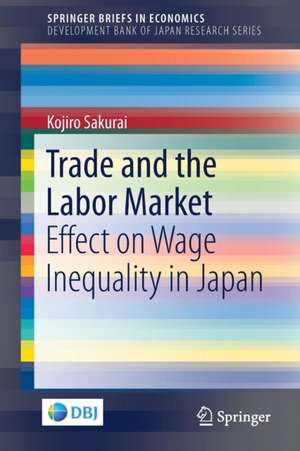Trade and the Labor Market: Effect on Wage Inequality in Japan: SpringerBriefs in Economics
Autor Kojiro Sakuraien Limba Engleză Paperback – 12 sep 2017
Main results are as follows: First, both relative wage and relative employment of nonproduction to production workers, and college graduates to high-school graduates increased as a trend since the 1980s, suggesting a relative demand shift toward skilled labor. Second, analysis using input-output tables revealed that employment reduction due to increased imports is greater in production workers than in nonproduction workers, and that employment increase due to increased exports is greater in nonproduction workers than in production workers, suggesting the comparative advantage being at work in line with the Heckscher-Ohlin-Samuelson model. Third, analysis using factor content of trade revealed that increased trade during 1995-2005 especially with Asian countries raised the relative wage of nonproduction to production workers in the aggregated manufacturing sector by 0.023 points (1.400 to 1.422), or by 1.6 percent in terms of rate of change. This estimation result suggests that increased trade in this period played a certain role in widening wage inequality between nonproduction to production workers. These results contribute to a deeper understanding of the effect of globalization on labor market in the field of economics.
Din seria SpringerBriefs in Economics
-
 Preț: 444.35 lei
Preț: 444.35 lei -
 Preț: 264.79 lei
Preț: 264.79 lei - 15%
 Preț: 462.51 lei
Preț: 462.51 lei -
 Preț: 47.33 lei
Preț: 47.33 lei -
 Preț: 353.14 lei
Preț: 353.14 lei -
 Preț: 273.32 lei
Preț: 273.32 lei -
 Preț: 376.04 lei
Preț: 376.04 lei -
 Preț: 379.09 lei
Preț: 379.09 lei -
 Preț: 380.07 lei
Preț: 380.07 lei -
 Preț: 377.35 lei
Preț: 377.35 lei -
 Preț: 379.09 lei
Preț: 379.09 lei -
 Preț: 376.59 lei
Preț: 376.59 lei -
 Preț: 408.27 lei
Preț: 408.27 lei -
 Preț: 379.09 lei
Preț: 379.09 lei -
 Preț: 383.28 lei
Preț: 383.28 lei -
 Preț: 378.54 lei
Preț: 378.54 lei -
 Preț: 377.95 lei
Preț: 377.95 lei -
 Preț: 340.23 lei
Preț: 340.23 lei -
 Preț: 380.25 lei
Preț: 380.25 lei -
 Preț: 378.12 lei
Preț: 378.12 lei -
 Preț: 376.04 lei
Preț: 376.04 lei -
 Preț: 376.04 lei
Preț: 376.04 lei -
 Preț: 379.68 lei
Preț: 379.68 lei -
 Preț: 381.00 lei
Preț: 381.00 lei -
 Preț: 375.23 lei
Preț: 375.23 lei -
 Preț: 376.80 lei
Preț: 376.80 lei -
 Preț: 378.54 lei
Preț: 378.54 lei -
 Preț: 377.57 lei
Preț: 377.57 lei -
 Preț: 376.04 lei
Preț: 376.04 lei -
 Preț: 378.92 lei
Preț: 378.92 lei -
 Preț: 375.62 lei
Preț: 375.62 lei -
 Preț: 379.09 lei
Preț: 379.09 lei -
 Preț: 353.67 lei
Preț: 353.67 lei -
 Preț: 342.14 lei
Preț: 342.14 lei -
 Preț: 375.45 lei
Preț: 375.45 lei -
 Preț: 379.09 lei
Preț: 379.09 lei -
 Preț: 377.35 lei
Preț: 377.35 lei -
 Preț: 344.86 lei
Preț: 344.86 lei -
 Preț: 377.35 lei
Preț: 377.35 lei -
 Preț: 345.89 lei
Preț: 345.89 lei -
 Preț: 377.57 lei
Preț: 377.57 lei -
 Preț: 343.83 lei
Preț: 343.83 lei -
 Preț: 378.12 lei
Preț: 378.12 lei -
 Preț: 345.06 lei
Preț: 345.06 lei -
 Preț: 379.48 lei
Preț: 379.48 lei -
 Preț: 379.48 lei
Preț: 379.48 lei -
 Preț: 380.07 lei
Preț: 380.07 lei -
 Preț: 375.45 lei
Preț: 375.45 lei -
 Preț: 445.33 lei
Preț: 445.33 lei -
 Preț: 378.54 lei
Preț: 378.54 lei
Preț: 411.16 lei
Nou
Puncte Express: 617
Preț estimativ în valută:
78.69€ • 81.85$ • 64.96£
78.69€ • 81.85$ • 64.96£
Carte tipărită la comandă
Livrare economică 15-29 aprilie
Preluare comenzi: 021 569.72.76
Specificații
ISBN-13: 9789811059926
ISBN-10: 9811059926
Pagini: 106
Ilustrații: IX, 106 p. 20 illus., 19 illus. in color.
Dimensiuni: 155 x 235 mm
Greutate: 0.18 kg
Ediția:1st ed. 2017
Editura: Springer Nature Singapore
Colecția Springer
Seriile SpringerBriefs in Economics, Development Bank of Japan Research Series
Locul publicării:Singapore, Singapore
ISBN-10: 9811059926
Pagini: 106
Ilustrații: IX, 106 p. 20 illus., 19 illus. in color.
Dimensiuni: 155 x 235 mm
Greutate: 0.18 kg
Ediția:1st ed. 2017
Editura: Springer Nature Singapore
Colecția Springer
Seriile SpringerBriefs in Economics, Development Bank of Japan Research Series
Locul publicării:Singapore, Singapore
Cuprins
1 Introduction.- 2 Basic Facts.- 3 Effect of Trade on Employment.- 4 Effect of Trade on Wages.- 5 Concluding Remarks.
Notă biografică
Kojiro Sakurai is a professor of economics at Senshu University and visiting scholar of the Research Institute of Capital Formation, Development Bank of Japan. His main areas of research are labor economics, international economics and Japanese economy. Born in 1956, Prof. Sakurai received a Bachelor’s degree in Economics from Hitotsubashi University in 1980, a Master’s degree in Economics from Yale University in 1984, and a Doctor’s degree in Economics from Hitotsubashi University in 2008. He was appointed Professor of Economics at Senshu University in 2007, after working for the Research Institute of Capital Formation, DBJ, as Chief Economist.
Caracteristici
Integrates international economics and labor economics Calculates factor content of trade Uses 55 manufacturing industries data Includes supplementary material: sn.pub/extras
